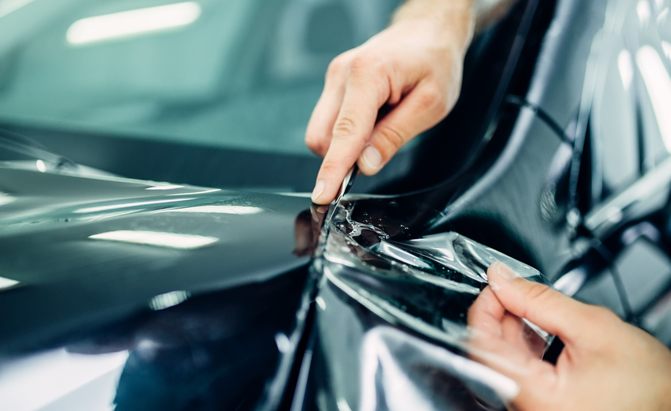How To Apply Paint Protection Film
If you’ve invested in a new car or are proud of the finish on your current ride, you’ll want to do everything you can to protect the paint job. While regular washing and waxing can help, they don’t offer complete protection against scratches, chips, and other damage. That’s where paint protection film (PPF) comes in. PPF is a clear, durable film that can be applied to your vehicle’s paint job to protect it from the elements and everyday wear and tear.
While you may be hesitant to apply PPF yourself, it’s actually a straightforward process that can save you money compared to having it professionally installed. By following a few simple steps, you can apply PPF to your vehicle with confidence and enjoy the benefits of added protection.
Get the Fail-Safe Paint Color Playbook (Free PDF)
36 proven colors • 8 ready palettes • trim & sheen guide • printable testing cards.
In this article, we’ll take you through the steps of how to apply paint protection film to your vehicle. We’ll cover everything from choosing the right type of film to preparing your vehicle’s surface and applying the film correctly. Whether you’re a seasoned DIYer or new to automotive projects, this guide will provide you with the information you need to protect your vehicle’s paint job and maintain its appearance for years to come.

Choosing the Right Paint Protection Film
Before applying PPF, it’s essential to choose the right type of film for your vehicle. PPF comes in different types, including self-healing, hydrophobic, and matte. The type of film you choose will depend on your specific needs and preferences. For example, if you want a film that can heal minor scratches on its own, a self-healing film would be ideal. Additionally, you’ll need to consider the size and shape of your vehicle when choosing a film. Some films come in pre-cut kits, while others require custom cutting.
When selecting a brand of PPF, it’s important to consider factors such as durability, clarity, and warranty. Some of the most popular brands of PPF include 3M, XPEL, and SunTek.
Preparing for Application
Proper preparation is essential to ensure a successful application of PPF. Begin by gathering all the necessary materials, including PPF, a squeegee, a spray bottle filled with a soap and water solution, a heat gun or hair dryer, and a knife or blade.
Next, clean the surface of your vehicle thoroughly, ensuring that it’s free of any dirt, debris, or wax. If necessary, use a clay bar to remove any contaminants that may be present on the surface. Once the surface is clean, rinse it thoroughly and dry it with a microfiber towel.
Applying the Film
Once you’ve prepared the surface and gathered all the necessary materials, you can begin the application process. Here’s a step-by-step guide to applying PPF to your vehicle:
- Measure and cut the PPF to fit the area of your vehicle you want to protect.
- Spray the soap and water solution on the surface of your vehicle and on the adhesive side of the PPF.
- Carefully place the PPF on the surface of your vehicle, making sure to align it properly.
- Use a squeegee to remove any air bubbles or excess solution from underneath the film.
- Use a heat gun or hair dryer to activate the adhesive and help the film conform to the surface of your vehicle.
- Trim any excess film using a knife or blade.
It’s important to take your time during the application process to ensure that the PPF is properly aligned and free of air bubbles. It may be helpful to have a friend assist you during the application process to make it easier to handle larger pieces of PPF.
Get the Fail-Safe Paint Color Playbook (Free PDF)
36 proven colors • 8 ready palettes • trim & sheen guide • printable testing cards.
After Application
After you’ve applied the PPF, it’s important to allow it to cure fully before exposing it to any harsh conditions. The curing time can vary depending on the type of film and the climate conditions. In general, it’s recommended to wait at least 24 hours before washing your vehicle or exposing it to rain or other harsh conditions.
To maintain the PPF, it’s important to clean it regularly with a gentle soap and water solution. Avoid using harsh chemicals or abrasive materials that can damage the film. Additionally, if you notice any damage or peeling of the film, it’s important to have it repaired or replaced as soon as possible to ensure continued protection of your vehicle’s paint job
Conclusion
Paint protection film is an excellent investment for anyone looking to protect their vehicle’s paint job from damage. While applying PPF may seem intimidating at first, it’s a straightforward process that can be completed with the right tools and techniques. By following the steps outlined in this guide, you can apply PPF to your vehicle with confidence and enjoy the benefits of added protection.
When choosing a type of PPF, consider your specific needs and preferences, and look for a brand that offers durability, clarity, and a good warranty. Proper preparation is essential for a successful application, so be sure to gather all the necessary materials and thoroughly clean the surface of your vehicle. During the application process, take your time and work carefully to ensure that the PPF is properly aligned and free of air bubbles.
After you’ve applied the PPF, allow it to cure fully before exposing it to harsh conditions, and clean it regularly with a gentle soap and water solution. With proper care and maintenance, paint protection film can provide long-lasting protection for your vehicle’s paint job.
